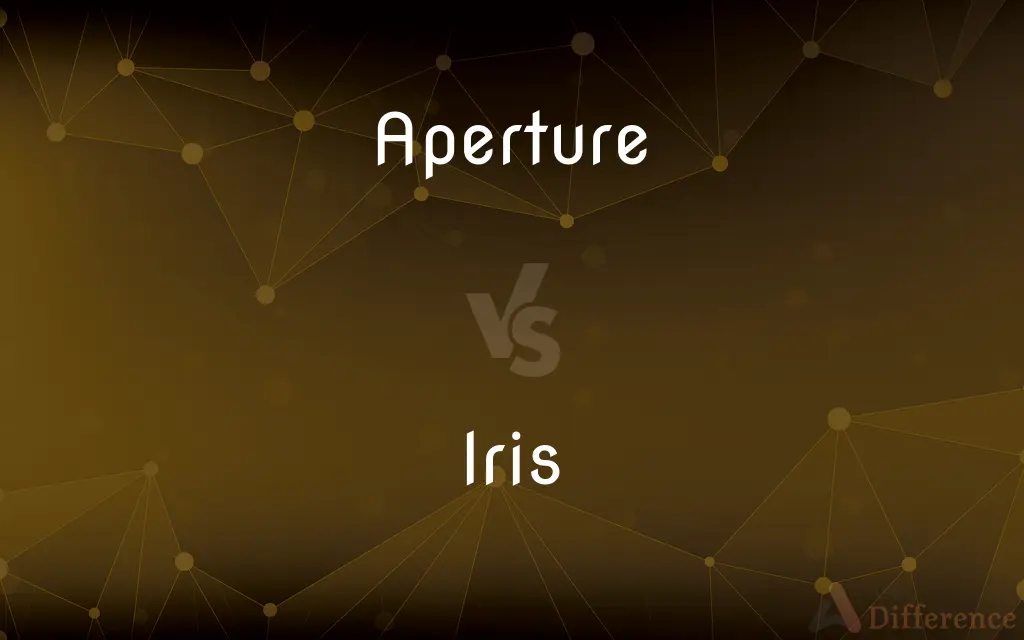Aperture vs. Iris — What's the Difference?
By Urooj Arif & Maham Liaqat — Updated on April 23, 2024
Aperture refers to the opening in a lens through which light passes to enter the camera, while iris is the mechanism that adjusts the size of this aperture.

Difference Between Aperture and Iris
Table of Contents
ADVERTISEMENT
Key Differences
The aperture is a central feature in cameras and optical devices that determines how much light reaches the film or image sensor. Whereas, the iris is the component of the lens that includes overlapping blades that can expand or contract to change the aperture's size.
A larger aperture allows more light to enter the camera, which is useful in low-light conditions and helps to create a shallow depth of field. On the other hand, the iris's ability to adjust means it can control not just light intake but also affect the depth of field and focus in a photograph.
The size of the aperture is often represented by f-numbers, such as f/1.8, f/4, f/16, etc., with lower numbers indicating a larger aperture. The iris, through its design, determines the range of these f-numbers by controlling how wide or narrow the aperture can be.
In photography, adjusting the aperture via the iris is crucial for achieving the desired exposure and depth of field. While the aperture itself is just the opening, the iris is the dynamic structure that allows photographers to manipulate these settings actively.
Both aperture and iris are essential for image quality, but while the aperture's size directly impacts light entry and depth of field, the iris provides the control needed to vary these effects based on the photographer’s needs.
ADVERTISEMENT
Comparison Chart
Definition
The opening in a lens that light passes through.
The mechanism that adjusts the size of the aperture.
Function
Controls the amount of light reaching the sensor or film.
Allows the aperture to be adjusted to different sizes.
Representation
Measured by f-numbers (e.g., f/1.8, f/16).
Composed of overlapping blades that can contract or expand.
Impact on Image
Directly affects light intake and depth of field.
Provides control over exposure and depth of field settings.
Operational Role
Static feature determining light entry.
Dynamic component enabling adjustment of light and focus.
Compare with Definitions
Aperture
Aperture settings are fundamental to achieving the correct exposure in photographs.
Photographers often adjust the aperture based on the lighting conditions.
Iris
Helps in refining the focus and depth of field by changing how wide the aperture is.
For portrait photography, a photographer might open the iris to achieve a blurred background.
Aperture
A hole or an opening through which light travels in an optical system.
Using a wide aperture like f/1.8 helps capture brighter images in dim settings.
Iris
Often automatically controlled in digital cameras but can be manually set in professional equipment.
Manual control of the iris gives seasoned photographers more creative control over their images.
Aperture
The size of the opening in a lens can be adjusted to control how much light enters.
Changing the aperture affects not only the brightness but also the depth of field of your photos.
Iris
Functions dynamically to increase or decrease the lens aperture during photography.
Adjusting the iris allows for quick changes in focus and depth effects.
Aperture
It is crucial for determining how sharp or blurred the background of an image will be.
A smaller aperture like f/22 is great for landscapes where you want everything in focus.
Iris
Essential for video as well, where lighting conditions can change rapidly.
In filmmaking, the iris adjustment is key to maintaining consistent exposure.
Aperture
Directly influences the brightness and overall exposure of an image.
An incorrect aperture setting can lead to underexposed or overexposed photos.
Iris
Part of a camera's lens system made up of multiple overlapping blades that adjust the aperture size.
The iris closes to a smaller size in bright conditions to reduce the amount of light entering the camera.
Aperture
In optics, an aperture is a hole or an opening through which light travels. More specifically, the aperture and focal length of an optical system determine the cone angle of a bundle of rays that come to a focus in the image plane.
Iris
The goddess of the rainbow and messenger of the gods.
Aperture
An opening, such as a hole, gap, or slit.
Iris
The pigmented, round, contractile membrane of the eye, suspended between the cornea and lens and perforated by the pupil. It regulates the amount of light entering the eye.
Aperture
A usually adjustable opening in an optical instrument, such as a camera or telescope, that limits the amount of light passing through a lens or onto a mirror.
Iris
Any of numerous widely cultivated plants of the genus Iris, having narrow sword-shaped leaves and showy, variously colored flowers.
Aperture
The diameter of such an opening, often expressed as an f-number.
Iris
A rainbow or rainbowlike display of colors.
Aperture
The diameter of the objective of a telescope.
Iris
An iris diaphragm.
Aperture
A small or narrow opening, gap, slit, or hole.
An aperture in a wall
Piriform aperture
Iris
(botany) A plant of the genus Iris, common in the northern hemisphere, and generally having attractive blooms (See Iris (plant)).
Aperture
(optics) A hole which restricts the diameter of the lightpath through one plane in an optical system.
Iris
(anatomy) The contractile membrane perforated by the pupil, which adjusts to control the amount of light reaching the retina, and which forms the colored portion of the eye (See Iris (anatomy)).
Aperture
The diameter of such a hole which restricts the width of the lightpath through the whole system. For a telescope, this is the diameter of the objective lens.
Angular aperture
This telescope has a 100 cm aperture.
Iris
A diaphragm used to regulate the size of a hole, especially as a way of controlling the amount of light reaching a lens.
Aperture
The (typically) large-diameter antenna used for receiving and transmitting radio frequency energy containing the data used in communication satellites, especially in the geostationary belt. For a comsat, this is typically a large reflective dish antenna; sometimes called an array.
Iris
(poetic) A rainbow, or other colourful refraction of light.
Aperture
The maximum angle between the two generatrices.
If the generatrix makes an angle θ to the axis, then the aperture is 2θ.
Iris
(electronics) A constricted opening in the path inside a waveguide, used to form a resonator.
Aperture
The act of opening.
Iris
(zoology) The inner circle of an oscillated color spot.
Aperture
An opening; an open space; a gap, cleft, or chasm; a passage perforated; a hole; as, an aperture in a wall.
An aperture between the mountains.
The back aperture of the nostrils.
Iris
To open or close in the manner of an iris.
Aperture
The diameter of the exposed part of the object glass of a telescope or other optical instrument; as, a telescope of four-inch aperture.
Iris
(literary) To cause (something) to shine with the colours of the rainbow; to make iridescent.
Aperture
A device that controls amount of light admitted
Iris
The goddess of the rainbow, and swift-footed messenger of the gods.
Aperture
A natural opening in something
Iris
The rainbow.
Aperture
An man-made opening; usually small
Iris
An appearance resembling the rainbow; a prismatic play of colors.
Iris
The contractile membrane perforated by the pupil, and forming the colored portion of the eye. See Eye.
Iris
A genus of plants having showy flowers and bulbous or tuberous roots, of which the flower-de-luce (fleur-de-lis), orris, and other species of flag are examples. See Illust. of Flower-de-luce.
Iris
See Fleur-de-lis, 2.
Iris
The inner circle of an oscillated color spot.
Iris
Same as iris diaphragm.
Iris
Plants with sword-shaped leaves and erect stalks bearing bright-colored flowers composed of three petals and three drooping sepals
Iris
Muscular diaphragm that controls the size of the pupil; it forms the colored portion of the eye
Iris
Diaphragm consisting of thin overlapping plates that can be adjusted to change the diameter of a central opening
Common Curiosities
What is the main difference between aperture and iris?
The aperture is the actual opening through which light passes, while the iris is the mechanism that adjusts this opening.
Is the iris manual or automatic in modern cameras?
Most modern cameras have automatic iris control, though manual options are available for professional use.
How does the iris affect photographic outcomes?
By changing the aperture size, the iris influences the amount of light, depth of field, and focus in an image.
How do you choose the right aperture setting?
Depending on the desired effect and lighting conditions, photographers select aperture settings to balance exposure and depth of field.
Why is aperture important in photography?
It determines how much light reaches the sensor, affecting exposure and the depth of field in images.
Are there cameras without adjustable apertures?
Some basic camera models and fixed aperture lenses do not have adjustable apertures.
Can the aperture exist without an iris?
Technically, yes, but without an iris, the aperture would not be adjustable, limiting the camera's flexibility.
How do aperture and iris work together in a camera?
The iris adjusts the size of the aperture to control light entry and depth of field as per the photographer's requirements.
What happens if the iris malfunctions?
A malfunctioning iris can result in improper exposure levels, impacting the quality of photographs.
What role does the iris play in video recording?
In video, the iris helps maintain consistent exposure and depth effects throughout varying lighting conditions.
Share Your Discovery

Previous Comparison
Burger vs. Hamburger
Next Comparison
Method vs. ProcedureAuthor Spotlight
Written by
Urooj ArifUrooj is a skilled content writer at Ask Difference, known for her exceptional ability to simplify complex topics into engaging and informative content. With a passion for research and a flair for clear, concise writing, she consistently delivers articles that resonate with our diverse audience.
Co-written by
Maham Liaqat















































